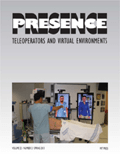
PRESENCE-Virtual and Augmented Reality
Scope & Guideline
Shaping Tomorrow's Reality, Today
Introduction
Aims and Scopes
- Immersive Technologies Research:
The journal publishes studies that explore the principles and effects of immersive technologies, including virtual reality, augmented reality, and mixed reality, on user experiences. - Applications in Education and Training:
A significant focus is placed on how VR and AR can enhance educational practices, particularly in healthcare and skill development, through innovative teaching methods and environments. - Psychological and Emotional Impact:
Research often investigates the psychological effects of immersive experiences, such as presence, embodiment, and emotional responses, highlighting the importance of user perception and interaction. - User Interaction and Engagement:
The journal examines user behaviors and interactions within virtual environments, including factors that influence engagement, loyalty, and overall user experience. - Multidisciplinary Approaches:
PRESENCE encourages interdisciplinary research that combines fields such as psychology, computer science, education, and art to foster a comprehensive understanding of immersive technologies.
Trending and Emerging
- Metaverse Technologies:
There is a growing interest in the implications and applications of metaverse technologies, particularly regarding user intentions, gratifications, and educational opportunities. - Healthcare Applications:
Research focusing on the use of immersive technologies in healthcare education and rehabilitation is trending, emphasizing their potential to enhance learning outcomes and patient experiences. - Emotional and Social Interactions:
Studies exploring emotional experiences and social interactions in virtual environments are gaining traction, highlighting the importance of user connection and empathy. - Gamification and User Engagement Strategies:
The exploration of gamification techniques within VR environments to boost user engagement and learning is on the rise, reflecting a shift towards interactive and participatory experiences. - Cross-Disciplinary Applications:
Emerging themes include the application of immersive technologies across various fields such as art, architecture, and social sciences, showcasing the versatility and adaptability of VR and AR.
Declining or Waning
- Basic Technical Development:
Research focusing solely on the technical development of VR and AR systems, without exploring user experience or application contexts, has decreased as the field matures. - Traditional Media Comparisons:
Comparative studies between traditional media (e.g., video, 2D screens) and immersive technologies are less prominent, as the focus shifts towards immersive experiences rather than comparisons. - Generalized Presence Studies:
Broader studies on presence that do not link to specific applications or user experiences have waned, as researchers now favor context-specific investigations. - Hardware-Specific Research:
There is a noticeable reduction in research dedicated to specific hardware advancements, as the focus has moved towards software applications and user interactions. - Single-Domain Focus:
Papers that concentrate on a single discipline (e.g., purely gaming or entertainment) are less common, as the journal seeks to promote more interdisciplinary discussions.
Similar Journals
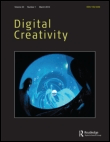
DIGITAL CREATIVITY
Unleashing the Power of Creativity in the Digital RealmDIGITAL CREATIVITY, published by Routledge Journals, Taylor & Francis Ltd, is a distinguished academic journal that serves as a vital platform for interdisciplinary research across the realms of Arts and Humanities, Computational Theory and Mathematics, Computer Graphics, and Human-Computer Interaction. Since its inception in 2005, this journal has aimed to explore the intersection of digital technologies and creative practices, making significant contributions to our understanding of digital aesthetics, interactive design, and the evolving nature of creativity in the digital age. With an impressive Q1 ranking in Arts and Humanities and notable standings in related computational fields, DIGITAL CREATIVITY appeals to a diverse audience of researchers, professionals, and students eager to engage with pioneering studies and innovative methodologies. While it presents valuable content primarily through subscription access, its credence in driving forward-thinking discussions is underscored by its ongoing relevance and commitment to advancing knowledge in a rapidly changing digital landscape. Join the conversation and contribute to shaping the future of digital creativity.
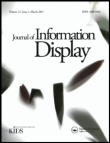
Journal of Information Display
Fostering collaboration in the realm of information display.Journal of Information Display is a leading academic journal published by TAYLOR & FRANCIS LTD, dedicated to advancing the field of display technology, which encompasses innovative research on materials and applications in electrical engineering. With its ISSN 1598-0316 and E-ISSN 2158-1606, this esteemed journal has been an open access resource since 2017, enabling widespread dissemination of knowledge and fostering a collaborative environment for researchers worldwide. Recognized for its impact, the journal is classified in the Q1 quartile in both Electrical and Electronic Engineering and Materials Science in 2023, showcasing its significant influence and relevance in these fields. Notably, it ranks highly in Scopus, with a ranking of #166 in Electrical and Electronic Engineering and #115 in General Materials Science, placing it within the top 20% of its category. The Journal of Information Display covers a broad scope from 2000 to 2024, making it a vital resource for professionals, academics, and students who seek cutting-edge research and developments in display technologies.

ACM Transactions on Applied Perception
Advancing Insights at the Intersection of Mind and MachineACM Transactions on Applied Perception is a leading journal published by the Association for Computing Machinery, focusing on the intersection of perception science and computational methods. With an ISSN of 1544-3558 and an E-ISSN of 1544-3965, this esteemed publication has been a vital resource for innovators and researchers since its establishment in 2004. It operates within the ambit of Computer Science and the realms of Experimental and Cognitive Psychology, boasting a commendable impact factor and category rankings, including Q2 in Computer Science (miscellaneous) and Q3 in both Experimental and Cognitive Psychology and Theoretical Computer Science. The journal's scope encompasses a plethora of studies aimed at understanding human perception through computational lenses, making it an essential platform for scholarly exchange. Although it does not currently offer an Open Access option, its extensive reach and rigorous peer-review process ensure high visibility and impact in the academic community. By fostering collaboration across disciplines, ACM Transactions on Applied Perception encourages advancements that bridge perceptual research with practical applications, making it invaluable for researchers, professionals, and students engaged in this dynamic field.

Frontiers in Virtual Reality
Shaping the Future of Immersive TechnologiesFrontiers in Virtual Reality, published by FRONTIERS MEDIA SA, is a leading open-access journal that has been at the forefront of the burgeoning field of virtual reality since its establishment in 2020. Based in Lausanne, Switzerland, this journal provides a vital platform for researchers, professionals, and students eager to explore and disseminate innovative findings related to virtual environments, immersive technologies, and human-computer interaction. With a commendable 2023 ranking placing it in the Q2 quartiles across prestigious categories such as Computer Graphics, Computer-Aided Design, and Human-Computer Interaction, the journal is highly regarded for its rigorous peer-review process and commitment to promoting scholarly communication. Frontiers in Virtual Reality not only advances the understanding of immersive experiences but also encourages interdisciplinary research that bridges the gaps between technology and human interaction. As an essential source of knowledge and a discussion forum for cutting-edge advances, this journal continues to shape the future of virtual reality research with easily accessible content and a responsive editorial approach.
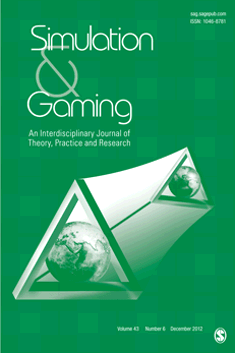
SIMULATION & GAMING
Bridging Disciplines with Engaging MethodologiesSIMULATION & GAMING, published by SAGE PUBLICATIONS INC, is a leading academic journal that explores the intersection of simulation and gaming within diverse fields such as business, social sciences, and computer science. With an ISSN of 1046-8781 and an E-ISSN of 1552-826X, this journal stands out in its commitment to advancing knowledge through high-quality research and innovative methodologies. As a testament to its influence, it is ranked Q1 in Social Sciences and Q2 in both Business, Management and Accounting, and Computer Science Applications, indicating its reputable position among scholars. Researchers, educators, and professionals will find valuable insights into the applications and implications of simulation and gaming, making it an essential resource for cutting-edge developments in these rapidly evolving domains. Access to its comprehensive archives allows for exploration of pivotal studies dating back to 1970, supporting the ongoing dialogue in this interdisciplinary area of research.
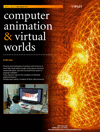
COMPUTER ANIMATION AND VIRTUAL WORLDS
Connecting Creativity with Cutting-edge Technology.COMPUTER ANIMATION AND VIRTUAL WORLDS, published by Wiley, is a pivotal journal in the fields of Computer Graphics and Computer-Aided Design, as well as Software. With a focus on the intersection of technology and creativity, the journal provides a platform for researchers and professionals to share innovative studies, new methodologies, and insights that shape the future of computer animation and virtual environments. Currently holding a Q2 category in Computer Graphics and a Q3 in Software for 2023, it ranks #63 out of 106 in its niche, highlighting its influence and relevance in the academic community. Though the journal operates under a subscription model, it also offers options for open access, ensuring that a broader audience can engage with groundbreaking research. The journal has been publishing continuously since its inception in 2004 and looks forward to further contributions as it moves towards its 20th anniversary in 2024. Whether you are a seasoned researcher, an industry professional, or a student eager to explore these dynamic fields, COMPUTER ANIMATION AND VIRTUAL WORLDS is an essential resource for advancing knowledge and innovation.

EDMETIC
Empowering scholars to reshape the educational landscape.EDMETIC is a premier open access journal dedicated to the field of educational technology and innovation, published by the University of Córdoba, Faculty of Education Sciences. With its ISSN 2254-0059 and E-ISSN 2254-0059, EDMETIC has been serving the academic community since 2012, providing a platform for the dissemination of high-quality research that explores the intersection of education and digital technologies. Situated in the vibrant city of Córdoba, Spain, this journal invites contributions from both established and emerging scholars worldwide. With a commitment to fostering critical discussions and advancements in educational practices, EDMETIC is pivotal for researchers, professionals, and students interested in the dynamic landscape of educational technology. Authors and readers benefit from its open access model, which ensures that groundbreaking research is accessible to all, promoting a culture of knowledge sharing and collaboration.

Information Technology & Tourism
Exploring the Digital Frontier of TravelInformation Technology & Tourism is a premier scholarly journal published by SPRINGER HEIDELBERG, focusing on the intersection of technology and tourism. With its ISSN 1098-3058 and E-ISSN 1943-4294, this esteemed journal boasts a remarkable impact factor and recognition as a Q1 journal in multiple categories, including Computer Science Applications, Information Systems, and Tourism, Leisure and Hospitality Management for the year 2023. The journal is notable for its rigorous peer-reviewed content, providing a platform for high-quality research and innovative practices that shape the future of the tourism industry through information technology. Researchers, practitioners, and students alike will find invaluable insights into emerging trends and technologies that drive efficiency and enhance customer experience within the tourism sector. With its converged time frame from 2014 to 2024, Information Technology & Tourism is poised to continue its influence, making it a crucial resource for anyone interested in the dynamic relationship between IT and tourism.

VIRTUAL REALITY
Pioneering Research in Computer Graphics and BeyondVIRTUAL REALITY is a prestigious journal published by SPRINGER LONDON LTD that has been at the forefront of the field since its inception in 1995. This journal, with an ISSN of 1359-4338 and E-ISSN 1434-9957, serves as an indispensable resource for researchers, professionals, and students interested in the rapidly evolving domains of computer graphics, human-computer interaction, and software development. VIRTUAL REALITY holds an impressive Q1 ranking across relevant categories, reflecting its high impact within the academic community, with specific rankings such as 11th overall in Computer Graphics and Computer-Aided Design and 31st in Human-Computer Interaction. This journal aims to publish cutting-edge research that explores theoretical advancements and practical applications related to virtual environments, contributing significantly to knowledge and innovation. With access options available through institutional subscriptions, it continues to shape the landscape of its field and inspire future research in immersive technologies.

Journal of Usability Studies
Enhancing interactions through rigorous research and analysis.The Journal of Usability Studies, published by the USERS EXPERIENCE PROFESSIONAL ASSOCIATION, is a pivotal platform for researchers and professionals dedicated to advancing the field of usability and user experience design. With an ISSN of 1931-3357, this journal offers a collection of peer-reviewed articles that explore innovative methodologies, emerging technologies, and applied research in usability studies. Though it operates under a traditional access model, the journal remains dedicated to fostering a detailed understanding of how users interact with systems and products. The Journal of Usability Studies is instrumental for those aiming to enhance user satisfaction through research-backed insights, making it a vital resource for academics, practitioners, and students seeking to contribute to the evolving discourse in human-computer interaction and usability engineering.